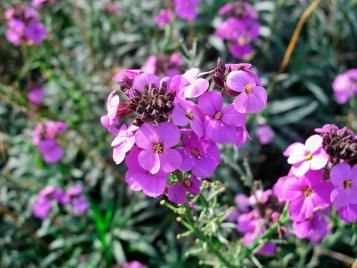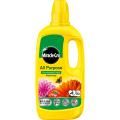Wallflowers are spring and summer-flowering bedding plants providing a wealth of colour for beds, borders and containers. Many also produce delightfully scented flowers. They can be annuals, biennials (growing in their first year and flowering in the second) or perennials.
When you say ‘wallflowers’, most people think of the spring-flowering bedding plants - Erysimum cheiri - previously called Cheiranthus cheiri. But there also numerous short-lived perennial types that flower for several months in spring and summer - and even well into autumn - such as the very popular Erysimum Bowles Mauve.

How to grow wallflowers
Cultivating wallflowers
Bedding wallflowers prefer to be grown in full sun but will tolerate light or dappled shade.
For best result they prefer a fertile soil enriched with lots of organic matter which holds plenty of moisture in spring and summer and doesn’t dry out or become waterlogged. However, they will tolerate poor soils. Add a general or high potash granular feed to the soil before planting out.
Perennial wallflowers need full sun and prefer poor to moderately fertile, well-drained, neutral or, preferably alkaline soil.
Sowing bedding wallflowers
Wallflower seeds are sown from May to July.
You can grow wallflowers from seed directly outside in the ground. Choose a sunny position with good, well-drained soil. Sow thinly at a depth of 13mm (0.5in) deep in rows 30cm (12in) apart. Cover the seed with fine soil and water in well. Water regularly, especially during dry periods. When the plants are large enough to handle you can transplant them to their final flowering positions.
It is usually better to sow wallflowers indoors in seed trays, cell trays or pots of good seed sowing compost at a temperature of around 13-15C (55-65F). Put the container inside a polythene bag or propagator. When seedlings are large enough to handle, transplant them individually into pots and grow them on in cooler conditions before planting outdoors in their final flowering positions.
When the young wallflower plants are 12.5cm (5in) tall pinch out the growing point to make them bush out.
Planting wallflowers
For bold, colourful bedding displays plant out around 30cm (12in) apart. The best time to plant out bedding wallflowers is in September or October.
If you don’t grow your own from seed then plug plants and seedlings are available from mail order seed companies and larger, ready-to-plant plants are available from garden centres. Traditionally these are available as bare root having been dug up out of the ground. Make sure the roots are given a good soaking in a bucket of water for 20-30 minutes before planting.
The perennial wallflowers like Bowles Mauve can be planted any time of year but the best time is during spring.
Growing wallflowers from cuttings
The perennial wallflowers aren’t grown from seed but are grown from cuttings taken in summer from the current year’s growth. It is possible to take cuttings from bedding wallflowers but this usually isn’t necessary as plants are cheap to grow or buy and usually perform better. Take cuttings around 7.5-10cm (3-4in) long, cutting just below a leaf joint or node. Heel cuttings (carefully pulling off the cutting with a piece of stem or ‘heel’ at the base) will often give better results. Prepare pots of suitable cuttings compost and water it well. Remove the leaves from the lower half to two-thirds of the stem and insert the stems up to the base of the leaves, spacing cuttings so the leaves don’t touch. Place the pot in a plastic bag or in a propagator and place somewhere warm to root that has good light but is out of direct sunlight.
Pot up plants individually once they have rooted and grow them on until they are big enough to plant out.
Where to plant wallflowers
Flower beds and borders, patios, containers, city and courtyard gardens, cottage, informal gardens and bedding displays.
How to care for wallflowers
Take care of wallflowers by keeping the soil or compost moist, especially when plants are flowering. Regular liquid feeds will help prolong the flowering period.
Deadheading plants and removing the developing seedpod may prolong flowering of bedding wallflowers.
After flowering cut back perennial wallflowers to keep them compact. This, along with liquid feeds, will also help encourage further flushes of flowers well into autumn.
Wallflowers may be susceptible to Clubroot disease.
| Flowering season(s) | Spring, Summer, Autumn |
|---|---|
| Foliage season(s) | Spring, Summer, Autumn, Winter |
| Sunlight | Full sun |
| Soil type | Chalky, Clay, Loamy, Sandy |
| Soil pH | Neutral |
| Soil moisture | Well-drained |
| Ultimate height | 30-75cm |
| Ultimate spread | 20-90cm |
| Time to ultimate height | 1-5 years |









